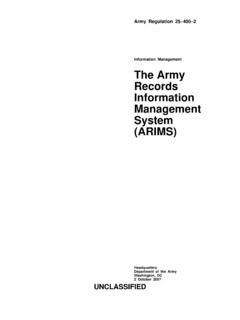Transcription of Technical Fact Sheet – N-Nitroso-dimethylamine (NDMA)
1 United States Office of Solid Waste and EPA 505-F -14-005 Environmental Protection Agency Emergency Response (5106P) January 2014 1 At a Glance Yellow liquid with faint characteristic or no distinct odor. Formerly used in the production of rocket fuel, antioxidants and softeners for copolymers. Currently used only for research purposes. Unintended byproduct of chlorination of wastewater at wastewater treatment plants that use chloramines for disinfection, raising significant concern as a drinking water contaminant. Highly mobile in soil, with potential to leach into groundwater. Oral route is the primary human exposure pathway. Classified as a B2 (probable human) carcinogen.
2 Listed as a priority pollutant by the EPA, but no federal standard has been established for drinking water. Detection methods include solid phase extraction, gas chromatography and liquid chromatography. Most common treatment method is via photolysis by ultraviolet radiation ranging in wavelength from 225 to 250 nanometers. Potential for aerobic and anaerobic biodegradation also exists. Technical Fact Sheet N-Nitroso-dimethylamine (NDMA) January 2014 Introduction This fact Sheet , developed by the Environmental Protection Agency (EPA) Federal Facilities Restoration and Reuse Office (FFRRO), provides a summary of the contaminant N-Nitrosodimethylamine (NDMA), including physical and chemical properties; environmental and health impacts; existing federal and state guidelines; detection and treatment methods; and additional sources of information.
3 This fact Sheet is intended for use by site managers and other field personnel who may address NDMA contamination at cleanup sites or in drinking water supplies. NDMA is a drinking water contaminant of concern because of its miscibility with water, as well as its carcinogenicity and toxicity. What is NDMA? NDMA is a semivolatile organic chemical that forms in both industrial and natural processes. It is member of N-ni- trosamines, a family of potent carcinogens (Cal/EPA 2006; Mitch and others 2003). Synonyms include dimethylnitrosamine ( dmna ), nitrosodimethylamine, N-methyl-N-nitrosomethanamine and N,N-dimethylnitrosamine (EPA IRIS 1993). NDMA is not currently produced in pure form or commercially used in the United States, except for research purposes.
4 It was formerly used in production of liquid rocket fuel, antioxidants, additives for lubricants and softeners for copolymers (ATSDR 1989; HSDB 2012). NDMA can be unintentionally produced in and released from industrial sources through chemical reactions, such as those that involve alkylamines with nitrogen oxides, nitrous acid or nitrite salts. Potential industrial sources include byproducts from tanneries, pesticide manufacturing plants, rubber and tire manufacturers, alkylamine manufacture and use sites, fish processing facilities, foundries and dye manufacturers (ATSDR 1989). NDMA is also an unintended byproduct of the chlorination of wastewater and drinking water at treatment plants that use chloramines for disinfection (Bradley and others 2005; Mitch and others 2003).
5 Technical FACT Sheet NDMA Technical FACT Sheet NDMA Disclaimer: The EPA prepared this fact Sheet from publically-available sources; additional information can be obtained from the source documents. This fact Sheet is not intended to be used as a primary source of information and is not intended, nor can it be relied upon, to create any rights enforceable by any party in litigation with the United States. Mention of trade names or commercial products does not constitute endorsement or recommendation for use. 2 Technical Fact Sheet NDMA Exhibit 1: Physical and Chemical Properties of NDMA (ATSDR 1989; Cal/EPA 2006; HSDB 2012; NIOSH 2010) Property Value/Description Chemical Abstract Systems (CAS) Number 62-75-9 Physical Description (physical state at room temperature) Yellow liquid with no distinct odor (ATSDR 1989; Cal/EPA 2006) Yellow liquid with faint, characteristic odor (NIOSH 2010; HSDB 2012).
6 Molecular weight (g/mol) Water solubility at 25oC Miscible Melting point (oC) -25 (estimated) Boiling point (oC) 152 (HSDB 2012) 154 (ATSDR 1989; Cal/EPA 2006) Specific gravity/Density at 20/4 oC (g/mL) (ATSDR 2012; Cal/EPA 2006) (HSDB 2012) Vapor pressure at 20oC (mm Hg) Organic carbon partition coefficient (log Koc) (estimated) Octanol-water partition coefficient (log Kow) Henry s Law Constant at 20oC (atm - m3/mol) x 10-7 (ATSDR 1989) x 10-6 (HSDB 2012) Abbreviations: g/mol grams per mole; oC degrees Celsius; g/mL grams per milliliter; mm Hg millimeters of mercury; atm - m3/mol atmosphere-cubic meters per mole. What are the environmental impacts of NDMA?
7 NDMA contamination may be found in air, soil and water (ATSDR 1999). When released to the air, NDMA is expected to exist solely as vapor in the ambient atmosphere and is broken down quickly by direct photolysis in sunlight. The estimated half-life of NDMA vapor in the ambient atmosphere with direct photolysis is about 5 to 30 minutes (ATSDR 1989). When released to soil, NDMA can be highly mobile and has the potential to leach into groundwater (HSDB 2012; Swarm and others 1983). In water, NDMA is completely miscible and is not expected to sorb onto solid particles or sediment. As a result of exposure to sunlight or by natural biological processes, NDMA may break down in water.
8 The estimated half-life for direct photolysis of NDMA in water is about 16 minutes. The rate of biodegradation in the natural environment has been observed to be highly variable (ATSDR 1999; HSDB 2012; Plumlee and Reinhard 2007). At rocket engine testing facilities in California, NDMA has been found at high concentrations in groundwater on site (up to 400,000 nanograms per liter [ng/L]) and also in downgradient drinking water wells (up to 20,000 ng/L) (Mitch and others 2003; EPA 2001b). In a 2002 survey conducted by the California Department of Health Services (CDHS), elevated concentrations of NDMA were detected in locations where wastewater treatment plant effluent was used for aquifer recharge and near facilities that use unsymmetrical dimethylhydrazine (UDMH)-based rocket fuel (CDHS 2002; Mitch and others 2003).
9 As of March 2011, NDMA had been detected in 1,787 samples out of 17,900 samples obtained from public water systems, which were monitored as part of the unregulated contaminant monitoring rule (UCMR). The EPA uses the UCMR to monitor contaminants that are suspected to be present in drinking water but that do not currently have health-based standards under the Safe Drinking Water Act (EPA 2011a). 3 Technical Fact Sheet NDMA What are the routes of exposure and health effects of NDMA? NDMA exposure may occur through (1) ingesting food that contains nitrosamines, such as smoked or cured meats and fish; (2) ingesting food that contains alkylamines, which can cause NDMA to form in the stomach; (3) drinking contaminated water; (4) drinking malt beverages (such as beer and whiskey) that may contain low levels of nitrosamines formed during processing; (5) using toiletry and cosmetic products such as shampoos and cleansers that contain NDMA; and (6) breathing or inhaling cigarette smoke.
10 Workplace exposure can occur at tanneries, pesticide manufacturing plants and rubber and tire plants (ATSDR 1989, 1999). The oral route, including consumption of contaminated food and water, is the primary human exposure pathway for NDMA (ATSDR 1989; Cal/EPA 2006). Exposure to high levels of NDMA may cause liver damage in humans (ATSDR 1999; HSDB 2012). Potential symptoms of overexposure include headache, fever, nausea, jaundice, vomiting, abdominal cramps, enlarged liver, reduced function of liver, kidneys and lungs and dizziness (HSDB 2012; O Neil 2006). In animal studies of various species including rats and mice, exposure to NDMA has caused tumors primarily of the liver, respiratory tract, kidney and blood vessels (DHHS 2011; IARC 1998).











